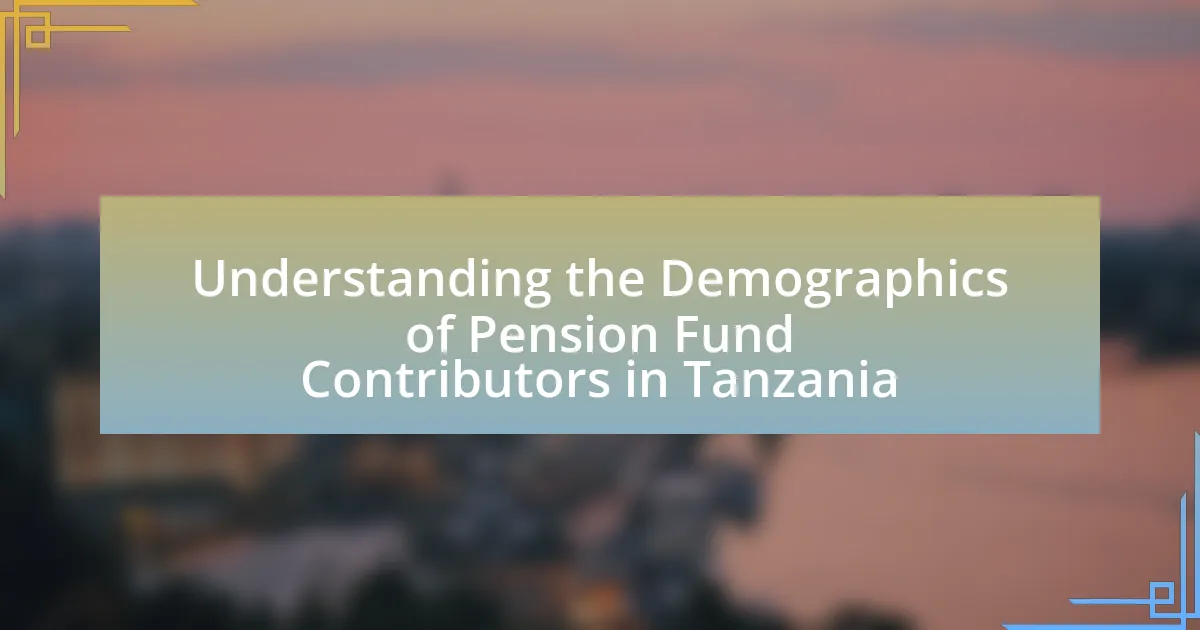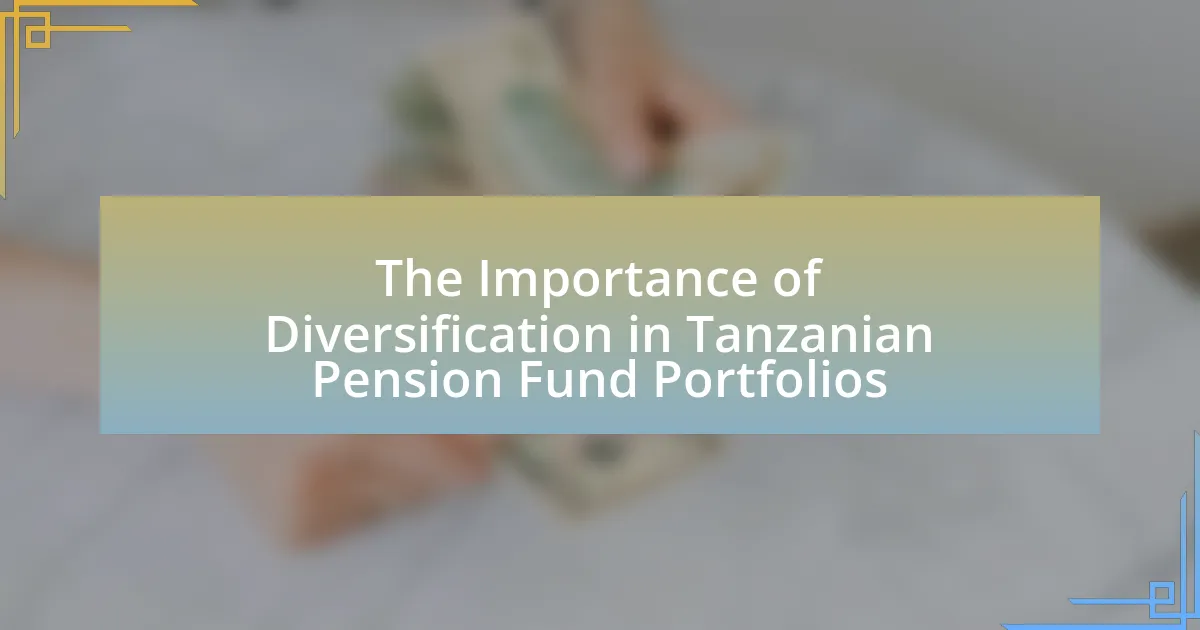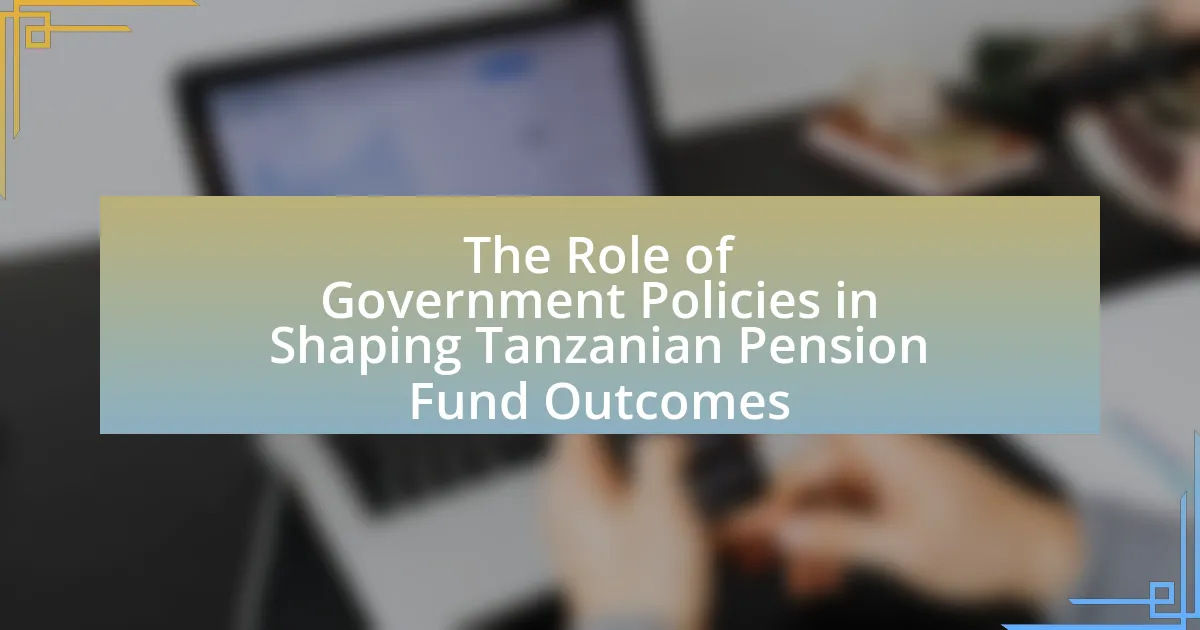The article evaluates the sustainability of Tanzanian pension funds in the context of various economic challenges, including regulatory frameworks, investment strategies, demographic trends, and economic conditions. It highlights how inflation, currency depreciation, and low investment returns impact fund performance and the ability to meet future liabilities. The discussion includes the role of government policy and regulatory frameworks in shaping pension fund management, as well as recent reforms aimed at enhancing fund viability. Additionally, it addresses demographic shifts, such as an aging population, and offers strategies for improving fund sustainability through diversification, risk management, and stakeholder engagement. The article concludes with recommendations for policymakers and fund managers to strengthen the pension fund sector in Tanzania.

What are the key factors influencing the sustainability of Tanzanian pension funds?
The key factors influencing the sustainability of Tanzanian pension funds include regulatory frameworks, investment strategies, demographic trends, and economic conditions. Regulatory frameworks establish the legal and operational guidelines that pension funds must follow, impacting their governance and risk management practices. Investment strategies determine how funds allocate assets, with diversification and risk assessment playing crucial roles in long-term viability. Demographic trends, such as aging populations and workforce participation rates, affect the inflow and outflow of contributions and benefits, directly influencing fund sustainability. Economic conditions, including inflation rates and overall economic growth, impact the financial health of pension funds by affecting investment returns and the ability to meet future liabilities.
How do economic challenges impact the performance of pension funds in Tanzania?
Economic challenges significantly hinder the performance of pension funds in Tanzania by reducing investment returns and increasing operational costs. For instance, high inflation rates erode the real value of pension fund assets, while currency depreciation affects the purchasing power of funds invested in foreign assets. Additionally, economic instability can lead to lower contributions from employers and employees, further straining the funds. According to the Bank of Tanzania, the inflation rate reached 4.2% in 2022, impacting the overall financial health of pension schemes. Furthermore, the World Bank has noted that economic downturns can lead to increased unemployment, resulting in decreased contributions to pension funds, which ultimately affects their sustainability and ability to meet future obligations.
What specific economic challenges are currently affecting Tanzanian pension funds?
Tanzanian pension funds are currently facing specific economic challenges such as inflation, currency depreciation, and low investment returns. Inflation in Tanzania has been fluctuating, impacting the purchasing power of pension payouts and eroding the real value of benefits. Currency depreciation against major currencies has made foreign investments less valuable, affecting the overall portfolio performance of pension funds. Additionally, low investment returns in domestic markets, exacerbated by economic instability and limited investment opportunities, hinder the growth of pension assets. These factors collectively threaten the sustainability and effectiveness of pension funds in providing adequate retirement benefits to beneficiaries.
How do inflation rates influence the sustainability of these funds?
Inflation rates significantly influence the sustainability of Tanzanian pension funds by eroding the purchasing power of the funds’ assets. As inflation rises, the real value of fixed-income investments declines, which can lead to insufficient returns to meet future liabilities. For instance, if inflation averages 5% annually, a pension fund must achieve returns exceeding this rate to maintain its purchasing power. Historical data from the Bank of Tanzania indicates that periods of high inflation have correlated with increased funding shortfalls in pension schemes, highlighting the critical need for these funds to adopt inflation-hedging strategies to ensure long-term viability.
What role does government policy play in the sustainability of pension funds?
Government policy is crucial for the sustainability of pension funds as it establishes regulatory frameworks, funding requirements, and investment guidelines that directly impact their financial health. For instance, policies that mandate minimum funding levels ensure that pension funds maintain sufficient assets to meet future liabilities, thereby enhancing their long-term viability. Additionally, government incentives for pension fund investments in sustainable projects can lead to better returns and reduced risks, aligning with broader economic goals. In Tanzania, the government has implemented reforms aimed at improving the governance and transparency of pension funds, which has been shown to increase public confidence and participation in these systems, ultimately contributing to their sustainability.
How do regulatory frameworks affect pension fund management in Tanzania?
Regulatory frameworks significantly influence pension fund management in Tanzania by establishing guidelines that govern investment strategies, risk management, and fund governance. These frameworks, primarily shaped by the National Social Security Fund Act and the Pension Act, dictate the permissible asset classes for investment, which impacts the diversification and risk profile of pension portfolios. For instance, the regulations require pension funds to invest a minimum percentage in government securities, thereby ensuring liquidity but potentially limiting higher-yield investment opportunities. Additionally, compliance with these regulations is monitored by the Pension Fund Regulatory Authority, which enforces standards that promote transparency and accountability, ultimately affecting the overall performance and sustainability of pension funds in the face of economic challenges.
What recent policy changes have been implemented to support pension funds?
Recent policy changes to support pension funds in Tanzania include the introduction of the National Pension Fund (NPF) Act amendments, which aim to enhance the financial sustainability and governance of pension schemes. These amendments focus on increasing contribution rates, improving investment strategies, and ensuring better regulatory oversight. For instance, the government has mandated that pension funds diversify their investment portfolios to include more infrastructure projects, which can yield higher returns. Additionally, the establishment of a Pension Fund Regulatory Authority has strengthened compliance and monitoring, ensuring that funds are managed effectively and transparently. These changes are designed to address the economic challenges faced by pension funds and improve their long-term viability.
What are the demographic trends affecting pension fund sustainability?
Demographic trends significantly impacting pension fund sustainability include aging populations, declining birth rates, and increasing life expectancy. In many countries, including Tanzania, the proportion of elderly individuals is rising, leading to a higher dependency ratio where fewer workers support more retirees. For instance, the United Nations projects that by 2050, the global population aged 60 and older will reach 2.1 billion, up from 1 billion in 2019. This shift places financial strain on pension systems as contributions from a shrinking workforce may not suffice to cover the benefits owed to a growing retiree population. Additionally, lower birth rates result in fewer young workers entering the labor market, further exacerbating the sustainability challenges for pension funds.
How does the aging population impact pension fund liabilities?
The aging population increases pension fund liabilities due to a higher number of retirees drawing benefits for longer periods. As life expectancy rises, pension funds face greater financial strain, necessitating larger reserves to meet future payouts. For instance, in Tanzania, the proportion of the population aged 60 and above is projected to rise significantly, leading to an increased dependency ratio. This demographic shift means fewer workers are contributing to the pension system while more beneficiaries are relying on it, thereby exacerbating the financial challenges faced by pension funds.
What is the current participation rate in pension schemes among Tanzanians?
The current participation rate in pension schemes among Tanzanians is approximately 10%. This figure reflects the low engagement of the workforce in formal pension systems, which is influenced by factors such as the prevalence of informal employment and limited awareness of pension benefits. According to the National Bureau of Statistics of Tanzania, as of 2022, only about 2.5 million out of an estimated 25 million workers are enrolled in pension schemes, highlighting the significant gap in participation.

What strategies can enhance the sustainability of Tanzanian pension funds?
To enhance the sustainability of Tanzanian pension funds, implementing diversified investment strategies is crucial. Diversification across various asset classes, including equities, bonds, and real estate, can mitigate risks and improve returns. For instance, the National Social Security Fund (NSSF) in Tanzania has begun investing in infrastructure projects, which not only provide stable returns but also contribute to national development. Additionally, adopting responsible investment practices, such as Environmental, Social, and Governance (ESG) criteria, can attract more investors and ensure long-term viability. Research indicates that pension funds that integrate ESG factors tend to outperform their peers, thereby reinforcing the financial health of the funds. Furthermore, enhancing regulatory frameworks to promote transparency and accountability will build trust among stakeholders, ensuring a more robust pension system.
How can investment diversification improve pension fund resilience?
Investment diversification can significantly improve pension fund resilience by spreading risk across various asset classes, which mitigates the impact of market volatility. When pension funds invest in a mix of equities, bonds, real estate, and alternative investments, they reduce their exposure to any single economic downturn. For instance, during the 2008 financial crisis, diversified funds experienced less severe losses compared to those heavily concentrated in equities. This strategy not only stabilizes returns over time but also enhances the fund’s ability to meet long-term obligations to beneficiaries, ensuring financial security even in challenging economic conditions.
What types of assets should pension funds consider for diversification?
Pension funds should consider a mix of equities, fixed income securities, real estate, commodities, and alternative investments for diversification. Equities provide growth potential, while fixed income securities offer stability and income. Real estate can serve as a hedge against inflation, and commodities can protect against market volatility. Alternative investments, such as private equity and hedge funds, can enhance returns and reduce correlation with traditional asset classes. Research indicates that a diversified portfolio can improve risk-adjusted returns, as evidenced by studies showing that diversified funds tend to perform better during economic downturns.
How does risk management play a role in investment strategies?
Risk management is essential in investment strategies as it helps identify, assess, and mitigate potential losses. By employing risk management techniques, investors can make informed decisions that balance potential returns with acceptable levels of risk. For instance, diversification is a common risk management strategy that spreads investments across various asset classes to reduce exposure to any single investment’s volatility. According to a study by the CFA Institute, effective risk management can enhance portfolio performance by minimizing drawdowns during market downturns, thereby supporting the long-term sustainability of investment funds, including pension funds in Tanzania facing economic challenges.
What best practices can be adopted for effective fund management?
Effective fund management can be achieved through diversification, regular performance monitoring, and adherence to regulatory compliance. Diversification reduces risk by spreading investments across various asset classes, which is crucial in volatile markets. Regular performance monitoring allows fund managers to assess investment strategies and make necessary adjustments, ensuring alignment with financial goals. Adhering to regulatory compliance safeguards against legal issues and enhances transparency, which is vital for maintaining stakeholder trust. These practices are supported by studies indicating that diversified portfolios tend to outperform concentrated ones over time, and consistent monitoring leads to better decision-making in fund management.
How can transparency and accountability be improved in pension fund operations?
Transparency and accountability in pension fund operations can be improved by implementing robust regulatory frameworks and enhancing stakeholder engagement. Regulatory bodies should enforce strict reporting standards that require pension funds to disclose detailed financial information, investment strategies, and risk assessments. For instance, the International Organization of Pension Supervisors emphasizes the importance of transparency in fostering trust and ensuring that funds are managed prudently. Additionally, involving beneficiaries in decision-making processes through regular consultations and feedback mechanisms can enhance accountability, as evidenced by studies showing that stakeholder participation leads to better governance outcomes.
What role does technology play in enhancing fund management efficiency?
Technology significantly enhances fund management efficiency by automating processes, improving data analysis, and facilitating real-time decision-making. Automation reduces manual errors and speeds up transactions, allowing fund managers to focus on strategic activities. Advanced data analytics tools enable better risk assessment and portfolio optimization, leading to more informed investment decisions. Furthermore, technology platforms provide real-time insights into market conditions and fund performance, which is crucial for timely adjustments in investment strategies. For instance, the use of artificial intelligence in predictive analytics has been shown to improve investment outcomes by up to 20%, demonstrating the tangible benefits of technology in fund management.
What collaborative efforts can strengthen the pension fund sector?
Collaborative efforts that can strengthen the pension fund sector include partnerships between government agencies, private sector stakeholders, and international organizations. These collaborations can enhance regulatory frameworks, improve investment strategies, and increase financial literacy among members. For instance, the International Labour Organization has emphasized the importance of multi-stakeholder dialogues to address pension sustainability, which can lead to more robust policies and practices. Additionally, joint initiatives for risk management and technology sharing can optimize fund performance and ensure better returns for beneficiaries.
How can partnerships with private sectors enhance fund sustainability?
Partnerships with private sectors can enhance fund sustainability by providing additional financial resources, expertise, and innovative solutions. These collaborations allow pension funds to diversify their investment portfolios, reducing risk and increasing potential returns. For instance, private sector partnerships can lead to co-investment opportunities in infrastructure projects, which have shown to yield stable long-term returns. A study by the World Bank indicates that pension funds that engage in public-private partnerships often experience improved financial performance and resilience against economic fluctuations. This evidence supports the notion that such partnerships are crucial for enhancing the sustainability of pension funds, particularly in challenging economic environments like Tanzania.
What initiatives can be taken to raise public awareness about pension savings?
To raise public awareness about pension savings, initiatives such as educational campaigns, community workshops, and partnerships with financial institutions can be implemented. Educational campaigns can utilize social media and traditional media to disseminate information about the importance of pension savings, targeting various demographics to ensure broad reach. Community workshops can provide hands-on learning experiences, allowing individuals to engage with financial advisors and understand their pension options. Collaborating with financial institutions can enhance these efforts by providing resources and expertise, as seen in successful programs in countries like Kenya, where similar initiatives have led to increased participation in pension schemes.

What are the future prospects for Tanzanian pension funds amid ongoing economic challenges?
The future prospects for Tanzanian pension funds are cautiously optimistic despite ongoing economic challenges. The Tanzanian government has been implementing reforms aimed at enhancing the regulatory framework for pension funds, which could improve their sustainability and investment performance. For instance, the introduction of the National Social Security Fund (NSSF) reforms in 2020 aimed to increase transparency and efficiency in fund management. Additionally, the growing economy, projected to expand by approximately 5.5% in 2023, provides a favorable environment for pension fund investments. However, challenges such as inflation and currency fluctuations remain significant risks that could impact fund performance. Overall, while economic challenges persist, proactive reforms and economic growth present a pathway for the future stability of Tanzanian pension funds.
How can pension funds adapt to changing economic conditions?
Pension funds can adapt to changing economic conditions by diversifying their investment portfolios and incorporating risk management strategies. Diversification allows pension funds to spread risk across various asset classes, such as equities, bonds, and alternative investments, which can mitigate the impact of economic downturns. For instance, during periods of low interest rates, pension funds may increase allocations to equities or real estate to seek higher returns. Additionally, implementing dynamic asset allocation strategies enables pension funds to adjust their investment mix in response to market conditions, enhancing their resilience. Historical data shows that pension funds that employed diversified strategies during the 2008 financial crisis were better positioned to recover compared to those with concentrated investments.
What innovative approaches are being explored to ensure fund viability?
Innovative approaches being explored to ensure fund viability in Tanzanian pension funds include diversification of investment portfolios, adoption of technology for better fund management, and collaboration with private sector entities. Diversification allows funds to spread risk across various asset classes, which can enhance returns and reduce vulnerability to market fluctuations. The use of technology, such as data analytics and blockchain, improves transparency and efficiency in fund operations, leading to better decision-making. Collaborating with private sector partners can provide additional resources and expertise, fostering sustainable growth. These strategies are essential for adapting to economic challenges and ensuring long-term fund sustainability.
How can pension funds prepare for potential economic downturns?
Pension funds can prepare for potential economic downturns by diversifying their investment portfolios to reduce risk exposure. Diversification allows pension funds to spread investments across various asset classes, such as equities, bonds, real estate, and alternative investments, which can mitigate losses during economic downturns. Historical data shows that during the 2008 financial crisis, pension funds with diversified portfolios experienced less severe impacts compared to those heavily invested in equities. Additionally, maintaining adequate liquidity ensures that pension funds can meet their obligations without having to sell assets at depressed prices during downturns.
What lessons can be learned from other countries’ pension systems?
Countries with diverse pension systems offer valuable lessons for improving sustainability and effectiveness. For instance, Sweden’s system emphasizes a balance between public and private contributions, ensuring a stable income for retirees while adapting to demographic changes. This model demonstrates the importance of flexibility and responsiveness to economic conditions. Additionally, the Netherlands showcases a strong emphasis on funded pension schemes, which have led to higher replacement rates for retirees, highlighting the benefits of robust funding mechanisms. These examples illustrate that integrating multiple funding sources and adapting to demographic shifts can enhance the resilience of pension systems, providing critical insights for Tanzania as it evaluates its own pension sustainability amid economic challenges.
What successful strategies have been implemented in similar economies?
Successful strategies implemented in similar economies include diversifying investment portfolios, enhancing regulatory frameworks, and promoting public-private partnerships. For instance, countries like Kenya and Ghana have successfully diversified their pension fund investments into real estate and infrastructure, which has led to improved returns and reduced risks. Additionally, Kenya’s regulatory reforms in the pension sector have strengthened governance and transparency, resulting in increased confidence among investors. Public-private partnerships in infrastructure projects have also been effective in both countries, facilitating better resource allocation and economic growth. These strategies have proven effective in enhancing the sustainability and resilience of pension funds in the face of economic challenges.
How can Tanzania leverage international best practices in pension fund management?
Tanzania can leverage international best practices in pension fund management by adopting transparent governance structures and implementing diversified investment strategies. Transparent governance, as seen in countries like the Netherlands, ensures accountability and builds trust among stakeholders, which is crucial for attracting more contributions to pension funds. Additionally, diversified investment strategies, similar to those employed by Canada’s CPP Investment Board, can enhance returns and mitigate risks, thereby improving the overall sustainability of pension funds. These practices have been shown to lead to more resilient pension systems, as evidenced by the robust performance of pension funds in developed economies during economic downturns.
What practical steps can stakeholders take to improve pension fund sustainability?
Stakeholders can improve pension fund sustainability by implementing diversified investment strategies, enhancing governance frameworks, and increasing transparency. Diversification reduces risk by spreading investments across various asset classes, which can stabilize returns during economic fluctuations. For instance, a study by the World Bank indicates that diversified portfolios can yield better long-term performance, particularly in emerging markets like Tanzania.
Enhancing governance frameworks involves establishing clear policies and accountability measures, which can lead to more effective decision-making and risk management. Research from the International Monetary Fund highlights that strong governance structures are linked to improved fund performance and sustainability.
Increasing transparency through regular reporting and stakeholder engagement fosters trust and allows for better-informed investment decisions. According to the Global Reporting Initiative, transparency in pension fund operations can lead to increased stakeholder confidence and participation, ultimately contributing to the fund’s long-term viability.
What are the key recommendations for policymakers and fund managers?
Key recommendations for policymakers and fund managers include enhancing regulatory frameworks to ensure transparency and accountability in pension fund management. Policymakers should implement policies that promote sustainable investment practices, aligning pension fund portfolios with environmental, social, and governance (ESG) criteria. Fund managers are advised to diversify investment strategies to mitigate risks associated with economic volatility, focusing on both local and international markets. Additionally, continuous education and training for fund managers on emerging financial trends and sustainability practices are essential to improve decision-making. These recommendations are supported by the need for robust governance structures, as evidenced by studies indicating that well-governed funds tend to perform better in challenging economic environments.
How can individuals contribute to the sustainability of their pension funds?
Individuals can contribute to the sustainability of their pension funds by actively engaging in responsible investment choices and advocating for sustainable practices within their pension schemes. By selecting funds that prioritize environmental, social, and governance (ESG) criteria, individuals can influence the allocation of capital towards sustainable projects. Research indicates that pension funds that incorporate ESG factors can achieve better long-term financial performance, thereby enhancing their sustainability. For instance, a study by the Global Sustainable Investment Alliance reported that sustainable investment assets reached $35.3 trillion globally in 2020, demonstrating a growing trend towards responsible investing.





